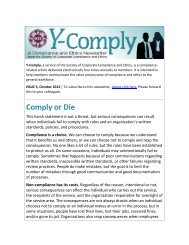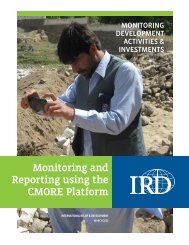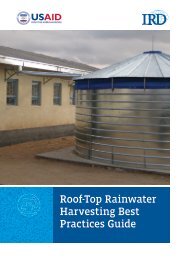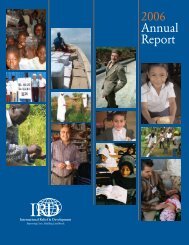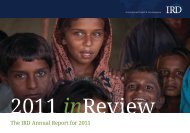Empowering citizens Engaging governments Rebuilding communities
Empowering citizens Engaging governments Rebuilding communities
Empowering citizens Engaging governments Rebuilding communities
Create successful ePaper yourself
Turn your PDF publications into a flip-book with our unique Google optimized e-Paper software.
IRD’s health advisor referred Omar<br />
Mohammad Abas to a hospital that specialized<br />
in treating amputees, where he was fitted<br />
with an artificial leg and underwent an<br />
intensive five‐week physical therapy program<br />
1<br />
Building community trust<br />
advisory council, the local governing authority. In doing<br />
so, the group learned of an effort to provide needy<br />
families with cooking oil and propane. But that effort<br />
had not been extended to Al Bir due to the lack of<br />
municipal capacity—simply put, the local government<br />
had no way to distribute the goods. So the citizen<br />
group responded, first by conducting a house-by-house<br />
needs assessment, then organizing a distribution<br />
network consisting of donated warehouse space and<br />
vehicles staffed by volunteers. Once the network<br />
was in place, the community action group developed<br />
a distribution schedule and a publicity campaign to<br />
inform residents about the program.<br />
Through the community action group, IRD helped put<br />
individual <strong>citizens</strong> directly in touch with government<br />
leaders. Even tenuous links between public and<br />
private interests, IRD believed, would help <strong>citizens</strong><br />
regain trust in their local political system and open<br />
doors to broader improvements in the physical and<br />
social infrastructure. The Al Bir group, for instance,<br />
had a broad impact. In addition to helping distribute<br />
cooking materials, it also helped coordinate a public<br />
health campaign to provide safe and sanitary circumcisions<br />
for young boys. IRD assisted the group in<br />
organizing qualified practitioners and nurses to come<br />
directly to families’ homes and perform the operation<br />
free of charge. The program proved very popular in<br />
the community: it was both low cost, and it improved<br />
local capacity to deliver health and social services,<br />
especially for children.<br />
With Iraq’s essential services in poor shape even<br />
before the 2003 invasion, community action group<br />
members placed their greatest priority on initiatives<br />
that would, among other things, revitalize roads,<br />
schools, medical facilities, sports facilities, sewage<br />
systems, and electricity delivery. Even with the<br />
improvements needed for services like water treatment<br />
and power supply, more than a third of the<br />
economic and social infrastructure budget was<br />
directed to school rehabilitation. A total of 278 school<br />
projects were completed through the infrastructure<br />
component. But with so much work to be done and<br />
so many people in need, program components often<br />
overlapped. Years into the conflict, Iraq’s Ministry of<br />
Education built a school in the Sadr district for 500<br />
children orphaned by the war. But the ministry did<br />
not have money to purchase generators, computers,<br />
or administrative supplies. After being contacted by<br />
the local community action group, IRD furnished the<br />
school with its missing equipment through ICAP’s<br />
Assistance to Civilian Victims (ACV) program.<br />
Addressing the needs of innocent victims<br />
Omar Mohammad Abas, an Iraqi university student,<br />
was standing outside his family’s home in May 2003,<br />
when a gunner on an American Humvee opened fire.<br />
Abas was not the intended target, but the gunfire<br />
struck him in the left leg. His injury was severe, and<br />
doctors were forced to amputate above his left knee.<br />
Almost two years later, in February 2005, the community<br />
action group representing Abas’s neighborhood<br />
brought his story to the attention of IRD mobilizers.<br />
IRD’s health advisor referred Abas to a hospital that<br />
specialized in treating amputees, where he was fitted<br />
with an artificial leg and underwent an intensive fiveweek<br />
physical therapy program.<br />
IRD financed Abas’s treatment and prosthetic leg with<br />
ACV funds. Launched during ICAP’s second year, the<br />
civilian assistance program was conceived as a way<br />
to provide relief for Iraqi civilians who were harmed as<br />
a direct result of US military operations. The congressionally<br />
earmarked funds were intended to benefit a<br />
wide range of Iraqis, from individual <strong>citizens</strong> to large<br />
families to entire <strong>communities</strong>. Projects were divided<br />
into a number of categories—community-based activities<br />
included reconstructing or expanding local civil<br />
services, such as orphanages, hospitals, or centers<br />
for the disabled; rebuilding or refurbishing individual<br />
14


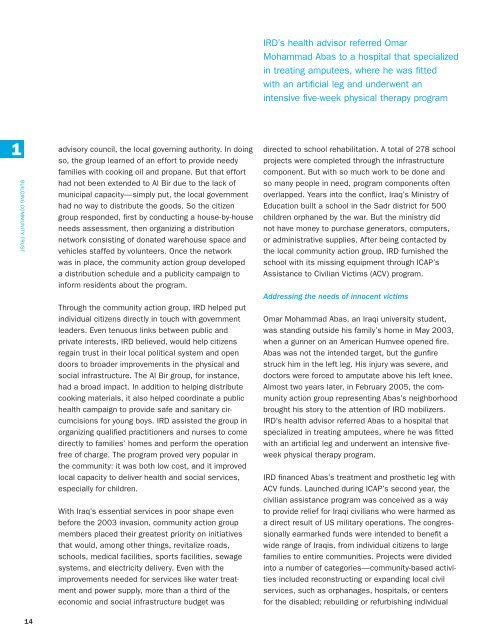
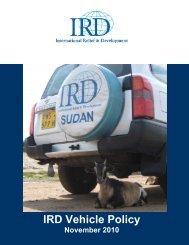
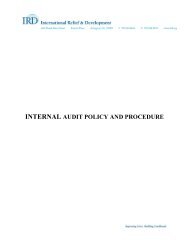
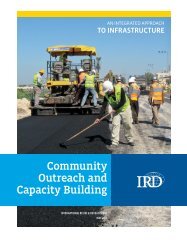
![Guide bonne pratique production d'oignon qualité_VF_4_2411012[1]](https://img.yumpu.com/23506639/1/184x260/guide-bonne-pratique-production-doignon-qualitac-vf-4-24110121.jpg?quality=85)

